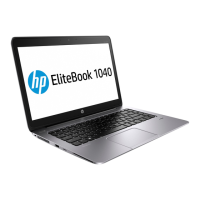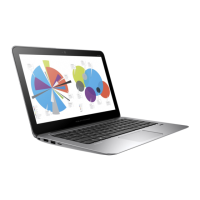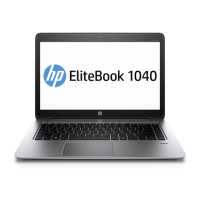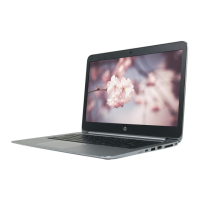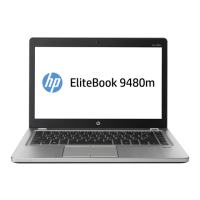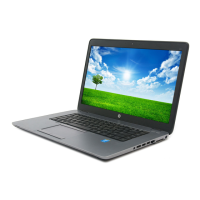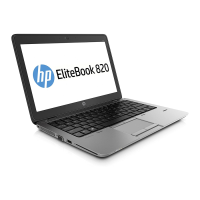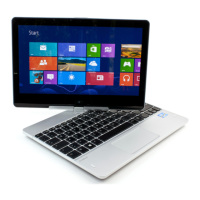Do you have a question about the HP elitebook folio g1 and is the answer not in the manual?
Identifies display components like antennas, microphones, and cameras.
Details components on the top panel, including the TouchPad and its controls.
Explains status indicators for power, call, mute, and wireless lights on the keyboard.
Describes the function of the power button for system power states.
Identifies function keys (ESC, FN, Windows) and their system functions.
Details the audio-out/audio-in combo jack for connecting audio devices.
Describes battery light and USB Type-C Thunderbolt-enabled ports.
Identifies and describes the speakers located on the bottom of the computer.
Explains the purpose and location of service, regulatory, and wireless certification labels.
Lists major computer components like display, keyboard, SSD, and system board with part numbers.
Details specifications for M.2 solid-state drives, including capacity and transfer rates.
Lists AC adapters, cables, and power cords with their respective part numbers.
Lists the essential tools needed for disassembly and reassembly procedures.
Essential notes on handling components, ESD prevention, and cable management.
Critical steps to prevent damage to drives during removal and handling.
Procedures to prevent electrostatic discharge (ESD) damage to computer components.
Instructions for safely packaging and transporting ESD-sensitive equipment.
Best practices for setting up a safe, static-free workstation for servicing.
Step-by-step guide for removing and replacing the computer's bottom cover.
Detailed instructions for safely removing and replacing the laptop battery.
Procedures for removing and replacing the solid-state drive (SSD) module.
Step-by-step guide for removing and replacing the speaker assembly.
Instructions for removing and replacing the computer's audio board.
Detailed guide for removing and replacing the TouchPad component.
Procedures for removing and replacing the main system board.
Step-by-step instructions for removing and replacing the display assembly.
Guide for removing and replacing the keyboard, including country-specific notes.
Overview of Computer Setup (BIOS) for managing system settings and startup.
Instructions on how to access and start the Computer Setup utility.
Guidance on navigating menus and making selections within Computer Setup.
Steps to reset Computer Setup settings to their original factory defaults.
Information on determining BIOS version and downloading/installing BIOS updates.
How to dynamically choose a boot device using the F9 prompt.
Instructions for modifying Trusted Platform Module (TPM) settings in BIOS.
Explains HP Sure Start technology for BIOS protection and recovery.
Steps to initiate HP PC Hardware Diagnostics for hardware testing.
Guide on downloading and creating HP PC Hardware Diagnostics on a USB drive.
Methods for creating system recovery media and backups.
Detailed steps for creating HP-specific recovery media.
How to use Windows tools for system restore points and personal data backups.
Overview of system restore, refresh, and reset options.
Instructions on how to modify the computer's boot order.
Steps to remove the HP Recovery partition to free up hard drive space.
Lists physical dimensions, weight, input power, and environmental specifications.
Provides detailed specifications for M.2 PCIe SSDs, including transfer rates and temperatures.
Instructions for restoring nonvolatile memory and BIOS settings to factory defaults.
Explains different types of nonvolatile memory and their purpose.
Provides answers to common questions about BIOS, UEFI, and memory.
General requirements for power cord set length, approval, and current capacity.
Lists country-specific requirements and certifications for power cords.
Identifies display components like antennas, microphones, and cameras.
Details components on the top panel, including the TouchPad and its controls.
Explains status indicators for power, call, mute, and wireless lights on the keyboard.
Describes the function of the power button for system power states.
Identifies function keys (ESC, FN, Windows) and their system functions.
Details the audio-out/audio-in combo jack for connecting audio devices.
Describes battery light and USB Type-C Thunderbolt-enabled ports.
Identifies and describes the speakers located on the bottom of the computer.
Explains the purpose and location of service, regulatory, and wireless certification labels.
Lists major computer components like display, keyboard, SSD, and system board with part numbers.
Details specifications for M.2 solid-state drives, including capacity and transfer rates.
Lists AC adapters, cables, and power cords with their respective part numbers.
Lists the essential tools needed for disassembly and reassembly procedures.
Essential notes on handling components, ESD prevention, and cable management.
Critical steps to prevent damage to drives during removal and handling.
Procedures to prevent electrostatic discharge (ESD) damage to computer components.
Instructions for safely packaging and transporting ESD-sensitive equipment.
Best practices for setting up a safe, static-free workstation for servicing.
Step-by-step guide for removing and replacing the computer's bottom cover.
Detailed instructions for safely removing and replacing the laptop battery.
Procedures for removing and replacing the solid-state drive (SSD) module.
Step-by-step guide for removing and replacing the speaker assembly.
Instructions for removing and replacing the computer's audio board.
Detailed guide for removing and replacing the TouchPad component.
Procedures for removing and replacing the main system board.
Step-by-step instructions for removing and replacing the display assembly.
Guide for removing and replacing the keyboard, including country-specific notes.
Overview of Computer Setup (BIOS) for managing system settings and startup.
Instructions on how to access and start the Computer Setup utility.
Guidance on navigating menus and making selections within Computer Setup.
Steps to reset Computer Setup settings to their original factory defaults.
Information on determining BIOS version and downloading/installing BIOS updates.
How to dynamically choose a boot device using the F9 prompt.
Instructions for modifying Trusted Platform Module (TPM) settings in BIOS.
Explains HP Sure Start technology for BIOS protection and recovery.
Steps to initiate HP PC Hardware Diagnostics for hardware testing.
Guide on downloading and creating HP PC Hardware Diagnostics on a USB drive.
Methods for creating system recovery media and backups.
Detailed steps for creating HP-specific recovery media.
How to use Windows tools for system restore points and personal data backups.
Overview of system restore, refresh, and reset options.
Instructions on how to modify the computer's boot order.
Steps to remove the HP Recovery partition to free up hard drive space.
Lists physical dimensions, weight, input power, and environmental specifications.
Provides detailed specifications for M.2 PCIe SSDs, including transfer rates and temperatures.
Instructions for restoring nonvolatile memory and BIOS settings to factory defaults.
Explains different types of nonvolatile memory and their purpose.
Provides answers to common questions about BIOS, UEFI, and memory.
General requirements for power cord set length, approval, and current capacity.
Lists country-specific requirements and certifications for power cords.
| Form factor | Clamshell |
|---|---|
| Product type | Laptop |
| Product color | Silver |
| Country of origin | China |
| Internal memory | 8 GB |
| Memory clock speed | 1600 MHz |
| Memory form factor | SO-DIMM |
| Internal memory type | LPDDR3-SDRAM |
| SSD capacity | The Solid State Drive's storage capacity in Gigabytes. |
| SSD interface | M.2 |
| Storage media | SSD |
| Optical drive type | No |
| Card reader integrated | Yes |
| Total storage capacity | 512 GB |
| Compatible memory cards | SD, SDHC, SDXC |
| Number of SSDs installed | 1 |
| Display surface | Matt |
| Display diagonal | 12.5 \ |
| Native aspect ratio | 16:9 |
| On-board graphics card ID | 0x191E |
| Discrete graphics card model | Not available |
| On-board graphics card model | Intel® HD Graphics 515 |
| On-board graphics card family | Intel® HD Graphics |
| Maximum on-board graphics card memory | 1.74 GB |
| On-board graphics card OpenGL version | 4.4 |
| On-board graphics card base frequency | 300 MHz |
| On-board graphics card DirectX version | 12.0 |
| On-board graphics card dynamic frequency (max) | 1000 MHz |
| Wi-Fi standards | 802.11a, Wi-Fi 5 (802.11ac), 802.11b, 802.11g, Wi-Fi 4 (802.11n) |
| Bluetooth version | 4.0 |
| Top Wi-Fi standard | Wi-Fi 5 (802.11ac) |
| Charging port type | DC-in jack |
| USB 2.0 ports quantity | 0 |
| Thunderbolt 3 ports quantity | 2 |
| Battery capacity | 38 Wh |
| Pointing device | Touchpad |
| Tcase | - °C |
| Bus type | OPI |
| Stepping | D1 |
| Tjunction | 100 °C |
| Processor cache | 4 MB |
| Processor model | m7-6Y75 |
| Processor family | Intel® Core™ m7 |
| Processor series | Intel Core m7-6Y series |
| Processor socket | BGA 1515 |
| Processor codename | Skylake |
| Configurable TDP-up | 7 W |
| Number of QPI links | - |
| Processor frequency | 1.2 GHz |
| Processor cache type | Smart Cache |
| Configurable TDP-down | 3.5 W |
| Processor lithography | 14 nm |
| Processor manufacturer | Intel |
| Processor front side bus | - MHz |
| PCI Express slots version | 3.0 |
| Processor boost frequency | 3.1 GHz |
| Processor operating modes | 32-bit, 64-bit |
| PCI Express configurations | 1x2+2x1, 2x2, 1x4, 4x1 |
| Thermal Design Power (TDP) | 4.5 W |
| Maximum number of PCI Express lanes | 10 |
| Processor code | SR2EH |
| Processor ARK ID | 88199 |
| Processor package size | 20 X 16.5 mm |
| Supported instruction sets | SSE4.1, SSE4.2, AVX 2.0 |
| Intel Smart Response Technology version | 1.00 |
| Operating system architecture | 64-bit |
| Sustainability certificates | ENERGY STAR |
| AC adapter power | 45 W |
| HP segment | Business |
| HP Software provided | HP BIOSphere, HP Sure Start, HP Connection Manager, HP Wireless Hotspot, HP PageLift, HP SoftPaq, HP File Sanitizer |
| Depth | 209 mm |
|---|---|
| Width | 292 mm |
| Height | 11.9 mm |
| Weight | 970 g |
